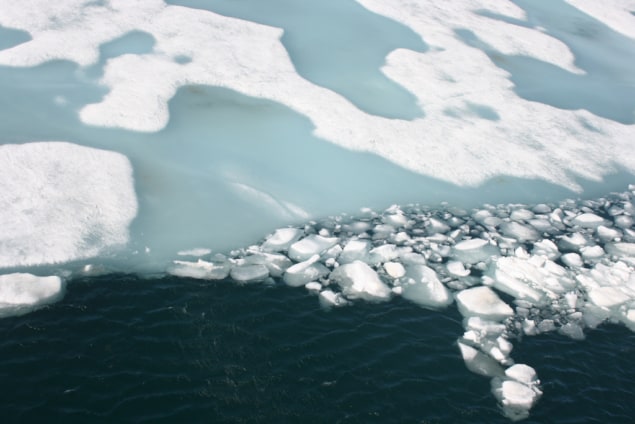
In just two decades the Arctic Ocean is likely to be ice-free during August and September, and by 2060 the Arctic Ocean will be ice-free throughout the summer months, according to a new systematic review.
“This will have far-reaching implications, well beyond the Arctic,” says Julienne Stroeve of University College London, UK. “The impact of this sea-ice loss on climate at lower latitudes and sea-level rise will be profound.” But the findings also indicate that Arctic sea-ice could be stabilised if we prevent global warming from overshooting 1.5 °C.
Stroeve and her colleagues assessed the changing state of Arctic sea ice by combining knowledge from observational records, atmospheric analyses and large-scale climate model simulations. The 40-year record of satellite observations together with measurements of sea-ice thickness enabled them to see if there were any trends in the data. Reanalysis of atmospheric data provided insights into changes in atmospheric circulation and air temperatures. Finally, climate model simulations, mostly from the Coupled Model Inter-comparison Project Phase 5 (CMIP5), enabled the scientists to understand why these changes have occurred.
These anomalies were larger than anything we had seen before in summer, and were not something we expected
Julienne Stroeve
Although losses of summer sea-ice often make the headlines, the researchers discovered that the anomalies in spring and winter sea-ice coverage have been most significant. For example, sea ice extent during the months of May and November 2016 was nearly four standard deviations below average, based on the years 1981 – 2010.
“These anomalies were larger than anything we had seen before in summer, and were not something we expected,” says Stroeve.
Meanwhile, decadal ice loss during the winter months has accelerated from -2.4% per decade from 1979-1999 to –3.4% per decade from 2000 onwards.
Because it’s highly reflective (it has a high albedo, in other words), sea ice bounces a large chunk of the Sun’s radiation back to space, cooling the planet. Once the ice melts, the dark waters underneath absorb more radiation, warming the ocean and the atmosphere.
“The melt season is starting earlier and ending later, which means that the warming ice-albedo feedback is bleeding into the shoulder months and operating over a longer time period,” says Stroeve. Eventually the sea ice melt and its associated warming will impact large-scale atmospheric and ocean circulation patterns, with far-reaching implications.
The research also shows that there is no doubt that carbon dioxide emissions are the culprit. Stroeve and her colleagues demonstrate a clear linear correlation between sea-ice extent and anthropogenic carbon dioxide emissions, with just over 1 sq. m of ice loss in winter and more than 3 sq. m of ice loss in summer every year for every ton of emissions.
By extrapolating this linear relationship, the researchers show that after a further 800 Gt of carbon dioxide emissions – by 2040 if current trends persist – the Arctic Ocean will become sea-ice free in August and September each year. After 1400 Gt of emissions, in around 2060 under current trends, the region will become sea-ice-free throughout the summer, from July to October.
“Given today’s emission rate of about 40 Gt of carbon dioxide per year, the time window is closing very rapidly to preserve Arctic sea-ice cover all year round,” the scientists warn in Environmental Research Letters (ERL). But if the world can manage to keep global warming under 1.5 °C, we might just manage.



